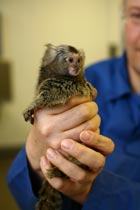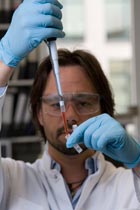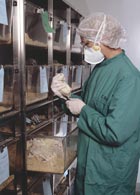



Context - Every year, more than 100 000 monkeys and apes are used for biomedical research around the world. Their genetic similarities to humans make them particularly suitable candidates for testing the safety of new drugs and for studying infectious diseases or the brain. But those very similarities to humans also raise specific ethical questions about their use for scientific experiments.
Are there alternatives to the use of non-human primates in research and testing? Would it be feasible to stop using them altogether?
An assessment by the European Commission Scientific Committees on Health and Environmental Risks (SCHER).
The answers to these questions are a faithful summary of the scientific opinion produced in 2009 by the Scientific Committee on Health and Environmental Risks (SCHER): "![]()
Around 12 million animals are used each year in scientific procedures in the EU, and among these, around 10 000 are non-human primates (NHPs), mainly monkeys and apes. Experiments on such primates have lead to important findings in biology and medicine.
Currently, primates are only used in animal experiments when there are no suitable alternative methods or species. They are mainly used for safety testing of pharmaceutical products and devices, but also for fundamental research in biology and for research and development of medical products and devices.
Nearly all primates used in scientific experiments are born to animals that are themselves bred in captivity, sometimes for several generations. With some exceptions, research on animals that are bred rather than caught in the wild tends to deliver more accurate and reliable data. Primates caught in the wild are very rarely used in research but are still needed to avoid the adverse effects of inbreeding of stocks.
With regard to animal welfare, major investments have been made in recent years to improve housing conditions of captive primates, taking into consideration their physical and social needs. More...

2.1 Before pharmaceuticals reach the consumer, their safety has to be tested on humans during clinical trials. Preliminary experiments on animals – often rats and dogs – are intended to protect the health of people taking part in these trials. Only few candidate pharmaceuticals are actually tested on non-human primates (NHPs). Primates are needed to test certain drugs with potential effects on female genital organs, eyes, birth outcomes, blood coagulation, or the brain, as they are the only mammals with specific physiological traits similar to humans. More...
2.2 In research on infectious diseases, vaccines and drugs that are developed are typically first tested on cells grown in the laboratory, then on animals, and finally on humans to check their safety and effectiveness. Primates often remain the most suitable animal option because their immune system is very similar to that of humans. Primate species are the only ones that can be used to develop effective malaria, tuberculosis, hepatitis C, or HIV vaccines and drugs for humans. Primates may also be needed to quickly detect new diseases such as SARS that could spread across the world. More...
2.3 Primates play a unique role in brain research because they are the only animals with brains that approach the complexity of the human brain. Research on pain and experiments on primates which require entering their skull raise difficult ethical concerns. Some new, non-invasive research techniques are being developed that can be used on humans and primates, but important limitations remain. More...
2.4 Using pig organs for transplantation is a way to address the shortage of organ donors. However, the human immune system rejects pig organs strongly. Only certain primate species show a similar immune response so any animal-testing of drugs to prevent transplant rejection has to be done on these species. More...

Alternatives to the use of non-human primates (NHPs) in research and testing do exist and can complement but not yet completely replace testing on these primates. As far as possible, the number of animals used should be reduced, methodologies should be refined, and the use of animals should be replaced by alternative methods (3Rs principle). More...
3.1 Because of scientific reasons, testing pharmaceuticals on non-human primates is in certain cases a very small but almost compulsory part of the global testing procedure, especially for drugs and vaccines that involve the immune system.
In certain cases, genetically modified rodents could potentially replace primates. Experiments on humans using extremely low doses of the new pharmaceutical being tested (microdosing) have also been proposed as an alternative to animal experimentation, but since prior tests on animals would still be needed to make sure that the small dose given is safe, it is not clear whether this would reduce the number of animals used. More...
3.2 In the search for new drugs and vaccines against HIV, hepatitis C, or malaria, tests are first carried out on cells grown in the laboratory, on mice, or on both. Such tests provide insight into the cell mechanisms, but cannot explain how a whole body would react to the infection. Experiments on non-human primates are therefore still needed. More...
3.3 Non-invasive techniques that study the brain without entering the skull are very useful and promising to understand healthy and diseased brains. However, such techniques are not yet as informative as invasive methods and still need to be further developed.
Computer modelling is rapidly improving but the human brain is so complex that a realistic model is unlikely in the foreseeable future. More...
3.4 Cells grown in the laboratory and rodents can be used to carry out preliminary research into the use of animal organs for transplantation, but transplants still need to be tested on animals, including primates. More...
In the foreseeable future, experimentation on non-human primates (NHPs) is unlikely to be completely replaced by laboratory methods or by test on other animal species.
For the safety testing of new pharmaceuticals, primates are also likely to remain the most suitable mammals.
To study HIV infection, genetically-modified mice will probably be available in the future. However, for scientific reasons, studies using mice cannot completely replace those using primates.
In research on the brains’ structure and function, non-invasive techniques which do not require entering the skull and computer modelling can be used alongside invasive methods but cannot replace them completely. However, new techniques and technologies are developing quickly and advances must be assessed frequently.
The development of artificial organs and tissues may reduce the need to use primates to test drugs that prevent rejection of animal organs (mostly pig organs) by humans. However, these artificial body parts are mainly used in life-support machines and do not represent an alternative to animal-to-human organ transplantation. More...

There are several ways to reduce the use of non-human primates (NHPs) in research areas where it cannot be avoided altogether:
In addition, clear information on the species and number of animals used for experimentation as well as on the types of tests involved should be publicly available. More...

There are several ways to enhance the welfare of non-human primates (NHPs) in scientific research.
The Scientific Committee on Health and Environmental Risks (SCHER) concludes that, because non-human primates (NHPs) have close and sometimes unique similarities to humans, their use remains necessary in the safety testing of new pharmaceuticals and in several areas of biomedical research, such as research on infectious diseases and on the brain.
The SCHER considered only scientific aspects, specifically excluding ethical, economic, cultural and social considerations which will be addressed by other groups.
At present, the SCHER sees no valid scientific arguments to stop using non-human primates for scientific research and drug safety testing, but this position should be frequently reviewed as new alternatives are constantly being developed.
The SCHER supports the “three Rs” principle of reducing, refining and replacing the use of non-human primates in scientific testing and makes a series of recommendations:

This summary is free and ad-free, as is all of our content. You can help us remain free and independant as well as to develop new ways to communicate science by becoming a Patron!